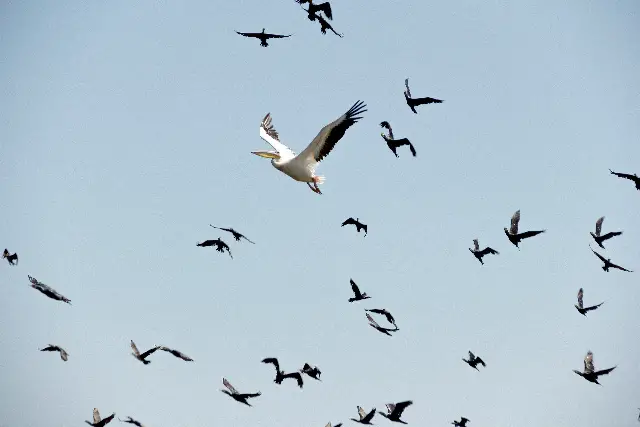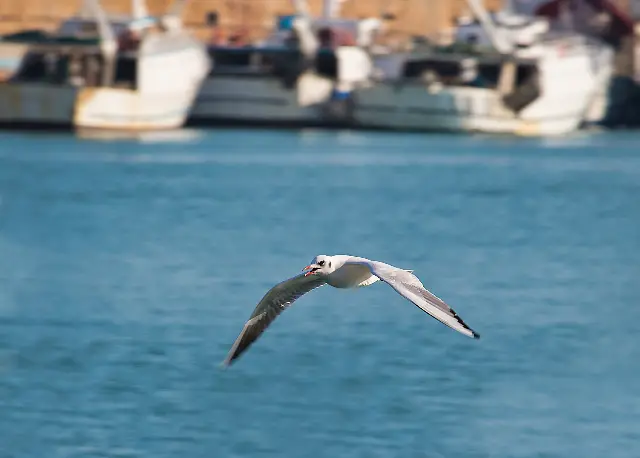Last Updated on July 10, 2023 By Emma W. Thomas
Seagulls often flock in large, random masses for several reasons. Firstly, it provides them with safety and protection against predators. Secondly, flocking allows them to locate food sources more efficiently. Additionally, flocking provides social interaction and communication opportunities among the seagulls. Overall, flocking in a large random mass benefits seagulls in terms of safety, food acquisition, and social dynamics within their community.
This article takes you through the different behaviors of seagulls, including why they swam in other areas, how they react toward earthquakes and weather changes, and their migration and timing. We also take you through the difference between gulls and seagulls, different species, what seagulls eat, and incredible facts about seagulls. Read on!
Reasons Why would seagulls flock in a large random mass
Seagulls flock in large random masses for various reasons, including:
- Safety and Protection: Flocking provides seagulls with safety in numbers. By gathering in large groups, they can confuse predators and make it harder for them to single out individual birds.
- Food Availability: Flocking allows seagulls to locate and exploit food sources more effectively. When one bird finds a food item, others notice and quickly join in, increasing the chances of successful foraging.
- Information Sharing: Flocking enables seagulls to communicate and share information. They can alert each other about potential food sources, predators, or other environmental cues.
- Social Interaction: Flocking facilitates social bonding among seagulls. It provides opportunities for grooming, courtship displays, and other social behaviors important for their species.
- Thermoregulation: Seagulls may gather in large groups to regulate body temperature. By huddling together, they can conserve heat during colder periods or minimize heat loss in windy conditions.
- Migratory Patterns: During migration, seagulls often form large flocks to travel together, benefiting from improved navigation, collective decision-making, and reduced individual effort.
- Dispersing Threats: When faced with disturbances, such as a predator or a perceived threat, seagulls may flock together to intimidate or distract the intruder, increasing their chances of survival.
- Roosting and Nesting: Flocking can be observed during roosting or nesting periods when seagulls gather in large numbers to rest or establish breeding colonies.
These reasons highlight the advantages of flocking for seagulls, providing them with safety, food acquisition, social connections, and adaptability to changing environmental conditions.
Why do seagulls swarm or congregate in an area?
Seagulls are scavengers. As earlier mentioned, these birds can feed on anything. Once they sense that they can acquire food from a specific place, they will undoubtedly flock to that area. The flesh is also one of their callings. As they will move closer to a place, they notice it.
Some people claim that birds swarming a place can indicate future destruction or an indicator of bad luck. This theory cannot be termed true. Nevertheless, even if you believe so, it is not right that you go ahead and attack the birds. Attacking them may be dangerous for you and the people around you as the birds may decide to attack and cause destruction.
Seagull Migration Pattern and Timing
Most seagull migrations happen during winter. They can choose to travel for a few miles to boost their foraging or go for thousands of miles while making several stops. Franklin’s gull has made the longest journeys as it travels from Canada to South America annually.
Seagulls’ behaviors in earthquakes and weather changes
For human beings, it is hard to sense any slight changes that occur in weather and air pressure without the necessary equipment. However, this is not the case in animals and birds because they get to sense any slight changes in climate and air pressure. This is why before hazards such as earthquakes, birds, such as seagulls, are seen to move away from such areas. Sailors take this advantage and look to the seagulls to determine weather conditions such as rain.
Seagulls are very sensitive creatures. Any fluctuations that occur in water or air that cannot be noticed easily, these birds can detect and react. They can also note infrasound which is of very low pulses and normally precede large storms and earthquakes.
Before a large storm, seagulls may stay ground for an hour or two before the storm hits. They also fly on low levels over the water’s surface. Sometimes, the seagulls may decide to fly in tight circular flocks to adjust their senses for proper balance and direction due to air pressure changes.
In one way or another, their behaviors and migrations can be used as a warning to prepare for calamities such as weather and change in weather such as storms, which had not been expected. However, not all animals’ and birds’ behaviors can be used in prediction.
What month do seagulls migrate?
Seagulls spend most of their summers in their breeding zones. They mostly travel towards the North during Spring. You may notice this when they make their stops to get food. They do not stay put in one place for a long time, and you will see them migrating from their breeding sites back to their previous locations in the late summer or mostly in the early fall. Their movement can be determined by seasons.
Where do seagulls go in the winter months?
When the winters are not as cold, the birds prefer to stay near the lakes. When the winter cold is slightly too much, they head south, searching for other open waters as they cannot depend on small lakes because they ice up quite fast.
The difference between gulls and seagulls
People tend to have difficulty differentiating between a gull and specifically a seagull most of the time. Looking into the physical characteristics is one of the confirmed sure ways to distinguish the two.
The table below comes in handy when comparing the two;
| Physical characteristics/ body part | SEAGULLS | GULLS |
| Body size | Seagulls are much larger. They have a height of up to 39 inches | They are smaller. They have a height of up to 25 inches |
| The beak | Their beaks are lighter, less strong, and fairly pointed | Their beaks are lighter, less strong, and are fairly pointed |
| The plumage color | They have shorter and square tail feathers Their feathers can either be white, black, or even brown | They have long and pointed tail feathers Their tails are mostly white and have some distinct black markings |
Different seagull species
The following are some of the common seagull species;
| Species | Characteristics |
| The herring gull | They are the most common and also most abundant gull species. Found almost everywhere in North America and Eurasia. |
| The Mediterranean Gull | It is large and heavy Found in North America and Europe The adult species of this kind have white bodies and gray backs, and their wingtips are darker |
| Gull-billed Tern | It is smaller as compared to the other species. Their bodies are divided according to color; the upper body parts are grey, while the underparts tend to be white. Their legs are dark and are almost black They have short yellow beaks which have black tips. They are known for their distinct long wings |
| The Laughing gull | They are black-headed They are coastal birds and are found from Florida to South America; inland to the sea It is a large bird Their upperparts are gray, while the underparts are white. They tend to have dark spots on their breast. Some of them have bright orange beaks. |
Gulls are known to be social birds which, as mentioned earlier, like traveling in flocks. However, it is also true that gulls can be dangerous when provoked. They can go to extremities such as killing people or causing very serious injuries from their sharp beaks and claws and stealing food from humans once in a while. Disease transmission is also possible as they congregate in large numbers and can spread diseases to humans, too; the best option is always to be careful if you have to be around them but if not, stay away from them. It is also important to note that they adapt very quickly and can therefore survive in various environments.
What do seagulls eat?
Seagulls eat almost everything. From insects, seafood, mangoes, you name it. What they eat depends on where they live. Fish is their favorite delicacy. Their main concern in water is always the fish and other seafood.

Incredible Facts about Seagulls
Scientists have different species of animals and birds under observation from time to time. Through these observations, they can notice very rare features or behaviors that the animals and birds have. For the seagull, they include;
They are very intelligent
It is claimed that they can remember some foraging strategies and even pass them down to the next generations.
Some seagulls have also dropped mollusk shells on rocks to break them. Funnily, some have even been spotted baiting fish with bread. Truly incredible!
They drink both fresh and saltwater
This makes them have an easier time when it comes to adapting to different habitats. They have a gland above their eyes specialized in collecting salty water and then flushing it out through the bird’s nostrils.
They have a special claw
This is a small claw halfway up on the bird’s lower leg. This claw helps the birds roost on high ledges without them falling off.
The lifespan of a seagull
The seagulls do not live for quite long. They live for a minimum of five years and fifteen years. They have to spend and live many years to attain adult plumage and an extra four years to gain sexual maturity. However, the time and years tend to differ for each type of seagull. For some, the duration may take longer.
Final word
Seagulls are unique and beautiful birds that have different distinguishing behavior. It is not unusual to find them flocking in large masses when they find food or when trying to communicate. As humans, we should try and maintain a good relationship with them as they may be dangerous if they feel attacked. These birds are ones to look out for, especially during their stopovers, to view their features, colors, and how they enjoy moving in the water as they dive to get fish and other seafood. They are incredible.
References:
https://www.bristolpost.co.uk/news/bristol-news/huge-flocks-seagulls-been-swarming-3125564
https://sciencing.com/seagull-behaviors-earthquakes-changes-weather-23098.html
Emma is a graduate of Domestic Science or Family and Consumer Sciences (Home Economics) from the University of Wisconsin. She has 7 years of experience Working with the strategic section of BestBuy and now writing full-time for Homeeon.
From Managing the Home, Interiors, Cleaning, and Exteriors to Gardening and everything about Making A Home Liveable – is her passion and this Homeeon is the result of this.
Emma loves decorating her home with the best stuff found online. She cares about quality over anything and writes reviews about them here in Homeeon. Get in touch with her over Pinterest.
Keep reading her blogs.

